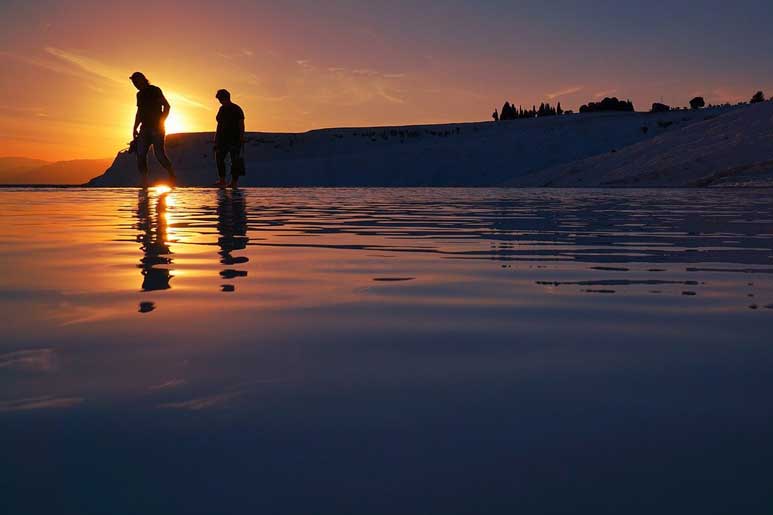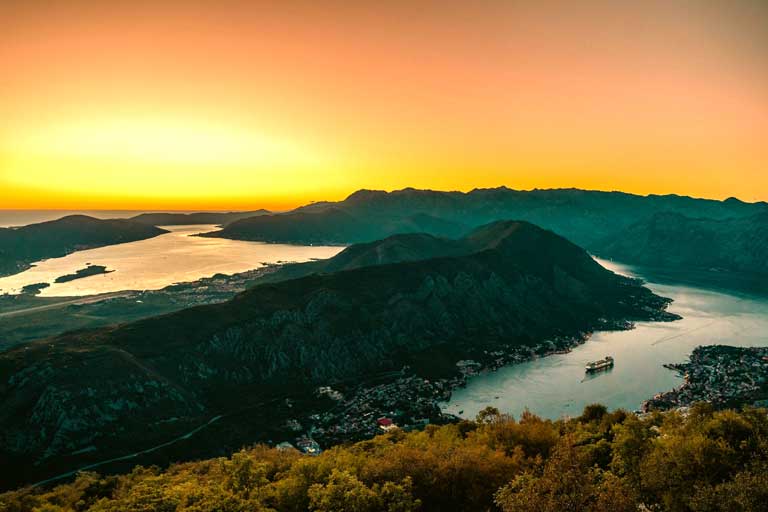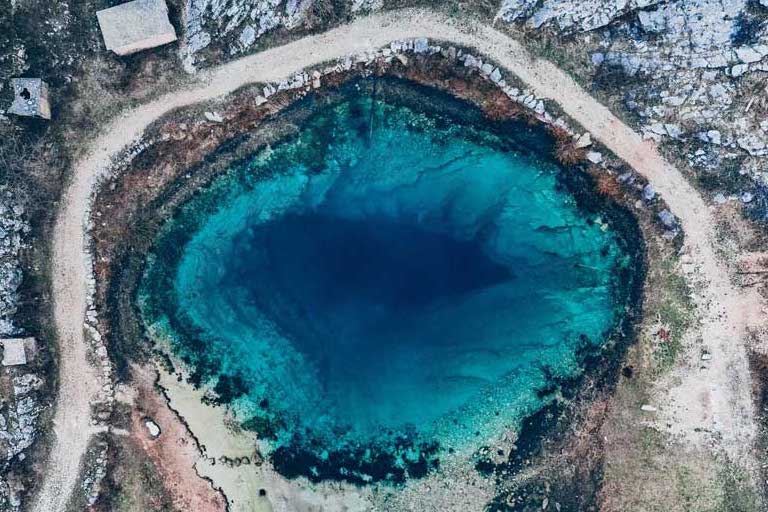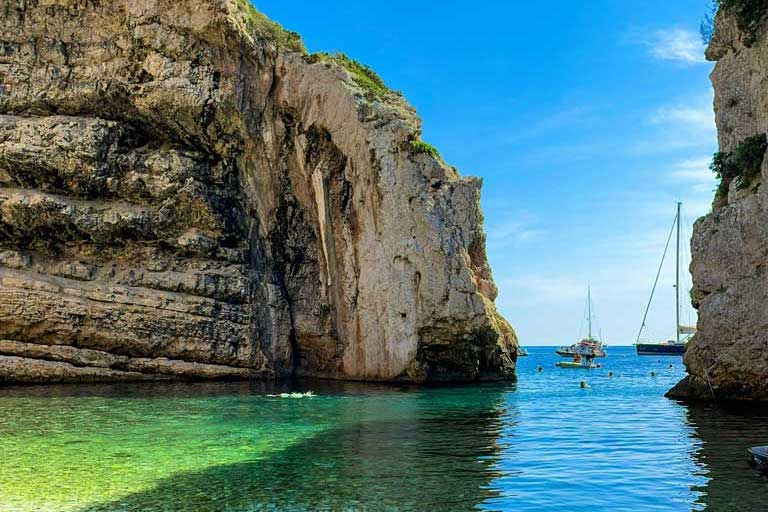Sunset at Pamukkale, Turkey has drawn visitors from across the globe. The magnificent sunset that continues to captivate people with its splendour occurs in the town of Pamukkale or “Cotton Castle.” The city has become famous for its mineral-rich pools in the backdrop of white cloudy travertine terraces.
Visualise the Captivating Sunset at Pamukkale, Turkey
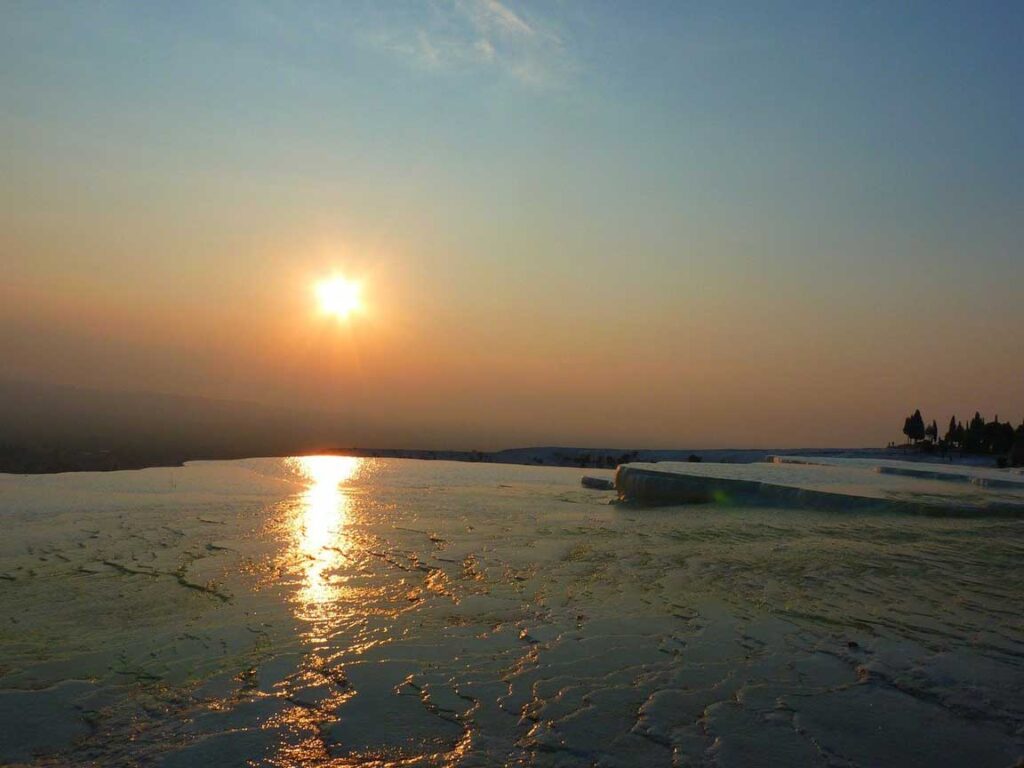
In Pamukkale, the day makes the white limestone terraces sparkle and shine whereas the sunset colours the sky a stunning orange-yellow hue. However, watching the marvellous sunset requires a strategy and quick feet because the staff will divert the water from one pool to another.
Before sunset they insert wood and aluminium shunts into trenches, rimming the travertine. In return, this redirects the water into a different cascade, and you want to be near one with water at sunset. More importantly, you need to do it quickly.
Once you’re standing near a pool, wait for the sky to transform into the glorious colours of fall. Now, look at the water to see the last seconds of the fleeting light reflect on the surface. You’ll see the colours’ dance — a melody of blues, pinks, purples, and oranges. Capture it to remind yourself of the moment that made a place in your heart forever — the Pamukkale sunset.
Catch The Beauty of Turkey with a Pamukkale Sunset
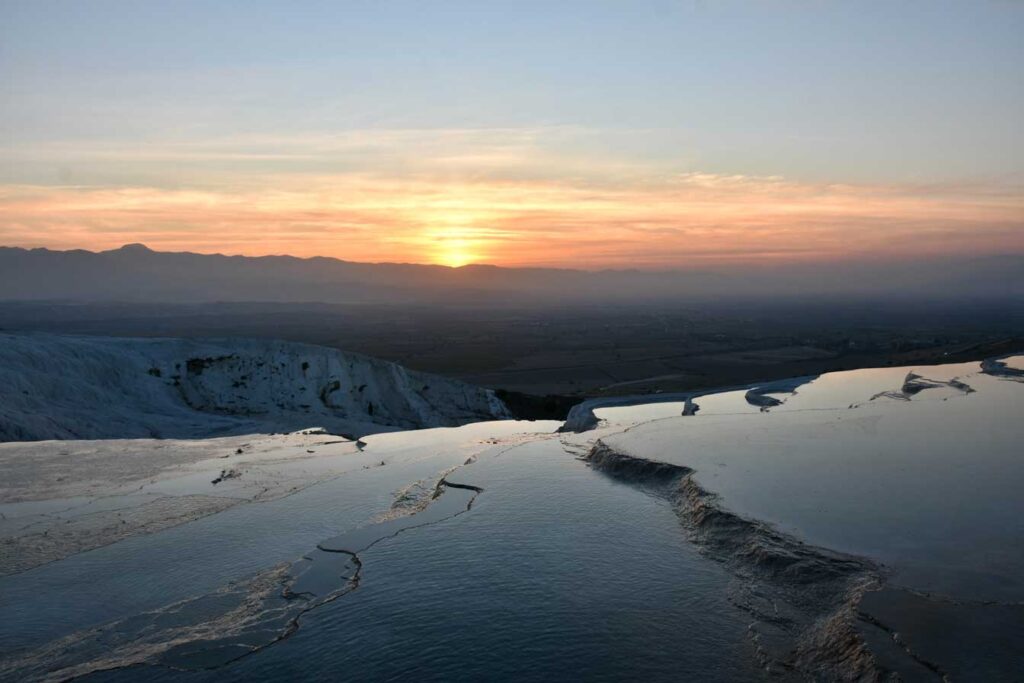
Although witnessing the sunset at Pamukkale with your own eyes is an unmatched experience, pictures can evoke precious memories, taking you back to that day in Turkey. Take a few pictures of the gorgeous sunset using your camera’s panoramic feature to take a landscape photo of the entire sky lit up with shades of orange and yellow.
Each picture will be unique, as every angle will display the sunset’s beauty differently. Stay until you see the sky turning into a scorching reddish-yellow mixed with brilliant copper tones. Make it into an adventurous day by exploring the surroundings followed by a relaxing dip into the pool until the sun departs.
Your day will end with impressive photos of the sky transitioning into nightfall but not before it puts on a light show!
Have a Soothing Experience at Cotton Castle Pamukkale
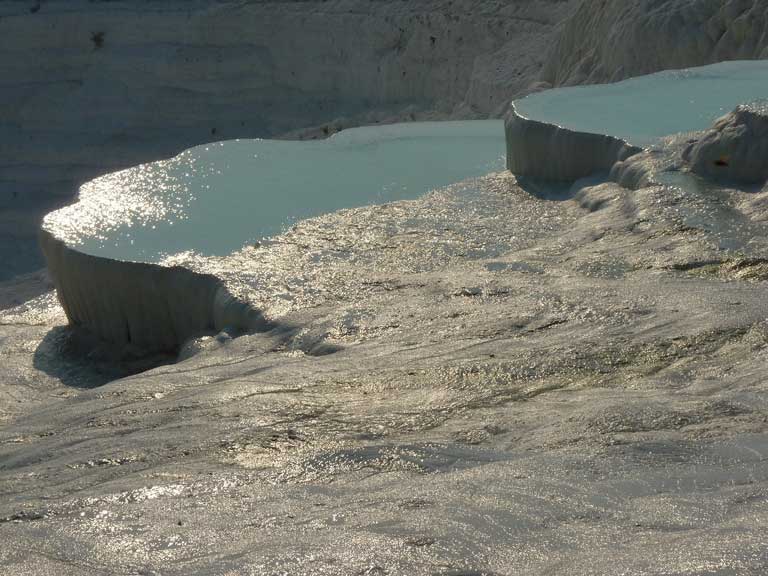
Pamukkale, situated in the Denizli Province, is Turkey’s star attraction. It means “Cotton Castle” in Turkish. People have one primary purpose to visit the city — to soak in the heated thermal pool. The city’s 17 calcium-rich, hot thermal pools, surrounded by white limestone terraces have been around for several thousand years.
The pool’s temperatures range from 19C to 57C. The Cotton Palace is built on top of the ruins of the historic city of Hierapolis. It became a healing centre in the 2nd century BC.
The Formation of the Ancient Pool
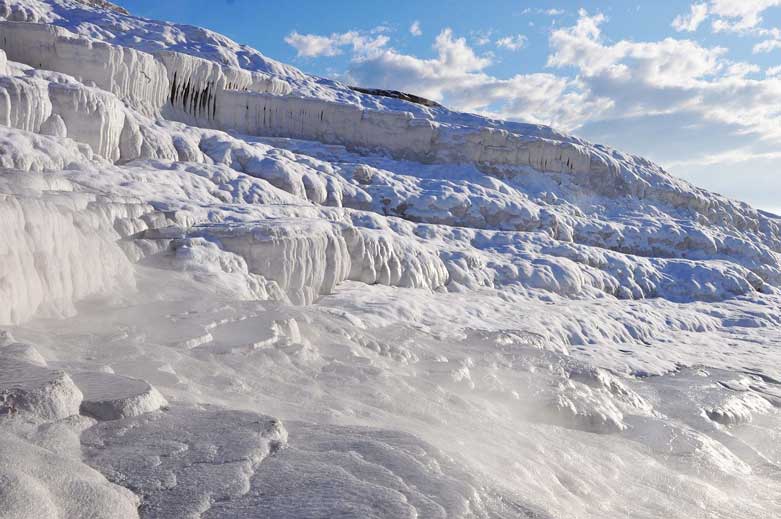
In 692 AD, an earthquake collapsed several structures, leading spring water to gather in the large crevices on the surface. Water, heated by volcanic lava, flowed onto the site from thermal springs. This caused the pools to form and, as a result, created terraces resembling small, fluffy clouds.
The hot water contains minerals, specifically calcium and carbon dioxide. Natural channels used to deposit water onto the travertine but now, water channels carry out that function. The spring water was also the architect behind Pamukkale’s cloud-like scenery.
Cotton Castle’s Beautiful and Unique Landscape
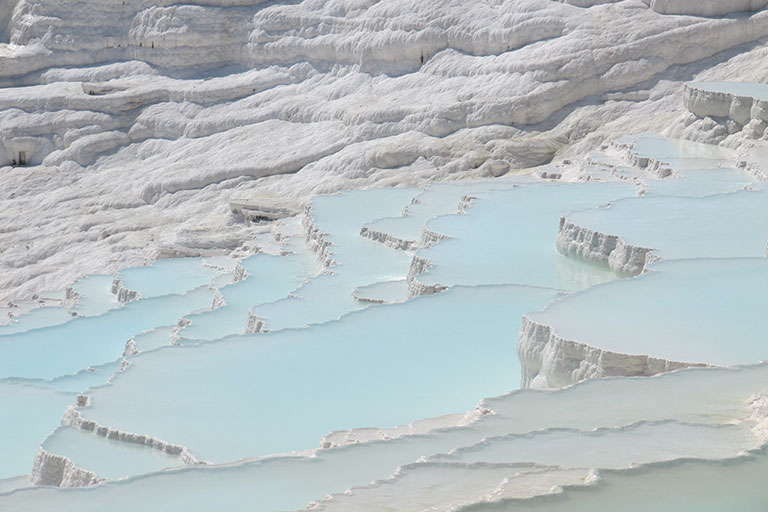
Cotton Castle Pamukkale offers unique landscape for sunset photos
Travertine, a type of limestone, makes up Pamukkale’s terraces. Water deposits the sedimentary rock onto the land. Here’s how it works: The water emerges from the thermal spring, travels 320m to the entrance of the terrace, and releases calcium carbonate.
When the water encounters the surface, carbon dioxide degasses, resulting in calcium carbonate. The deposition stops when water and air have equal amounts of carbon dioxide. Calcium carbonate takes the shape of soft jelly and then hardens in the travertine.
The calcium-rich salt baths have fascinated people for centuries with people traveling to take a dip in the pool, believing it to have healing benefits.
Health Benefits of Pamukkale Thermal Pools
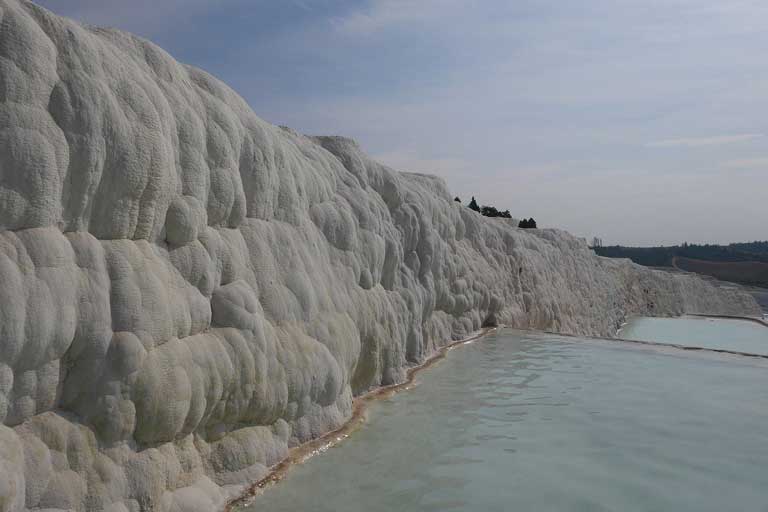
For centuries and to this day, people believe the travertine pools offer numerous health benefits for:
- asthma
- skin diseases
- stroke
- rheumatism
- chronic disorders
- kidney stones
- high blood pressure
- eye diseases
- digestive issues
- nutritional disorders
- circulatory disorders
- physical exhaustion
The pool’s healing properties have made Pamukkale one of Turkey’s top destinations to visit. UNESCO recognised it as a World Heritage Site in 1988.
Is It Worth Going to Pamukkale?
- See the wondrous city that resembles a giant castle made from small soft clouds.
- Soak in a pool loaded with minerals to receive the purported health benefits.
- Feel the warm water gracing your skin.
- Explore the ruins of ancient structures.
- View the breathtakingly beautiful sunset at Pamukkale, Turkey making the sky orange and yellow.
If that sounded appealing to you, you have already answered the question. Yes! The star of Denizli province, Pamukkale is worth visiting. The mystery, legends, and history surrounding the city are all compelling reasons to go. The real catch is the pools with heated water, packed with minerals and believed to have therapeutic properties.
That’s not all you’ll find there! Apart from the natural pool, there’s also a manmade pool. Cleopatra’s Pool or the Antique Pool Pamukkale was created by Mark Antony for his wife, the Egyptian Queen Cleopatra.
11 Places to Visit on Your Trip to Pamukkale, Turkey
Here are a few places in Pamukkale, Turkey that you’ll find fascinating:
1. Cleopatra’s Pools
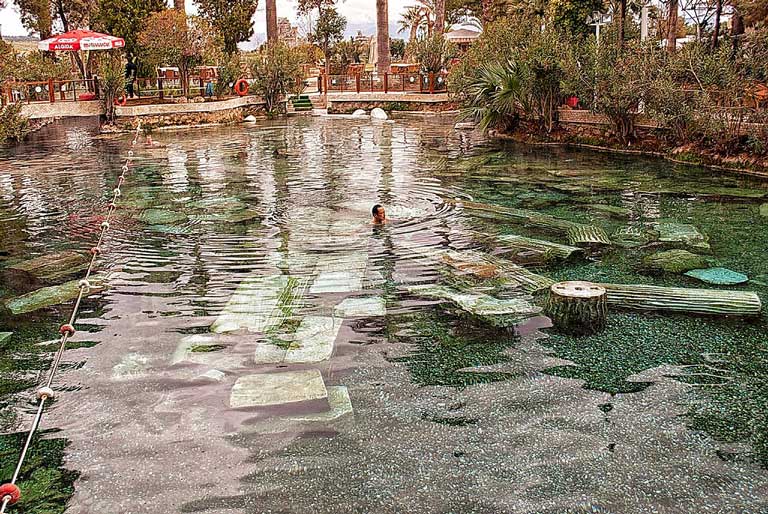
Cleopatra’s Pools or the Antique Pool Pamukkale was built by the Roman general and politician Mark Antony for his wife Cleopatra, the Queen of Egypt. The pool, lined with beautiful green trees, has sunken treasure sitting at the bottom.
It is the remains of the Temple of Apollo that fell into the Pamukkale Antique Pool after a devastating earthquake struck the city. You can swim around the ruins. You can sit in the pool to benefit from the mineral-rich hot spring also known as a champagne pool due to the bubbles moving in the water and gliding across your body.
2. Ancient City of Hierapolis
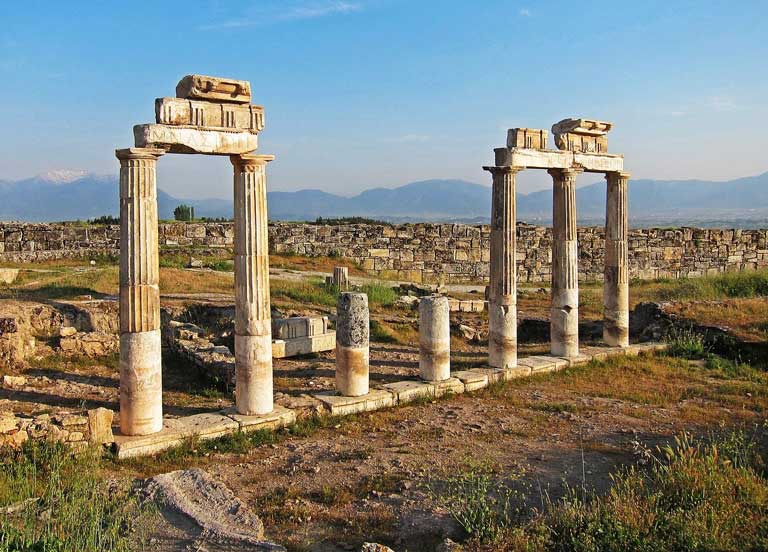
Hierapolis, the Greek and historic city of Turkey, was built on top of geothermal pools by the Romans in the 2nd century BCE. Later, they gave it to the Pergamon King Eumenes II in 190 BCE. The pool’s curative properties became popular among people who used to frequent it several times.
However, a series of earthquakes destroyed the city in the 14th century and it was beyond repair. The forgotten city rose from the ashes when archaeologists became interested in excavating it in the 19th century.
The archaeologists uncovered a gym, baths, a Byzantine church, as well as an agora. The 20th century brought tourism to the ancient city. People came to relax in the pools and explore the ruins of Hierapolis.
3. Hierapolis Archaeology Museum
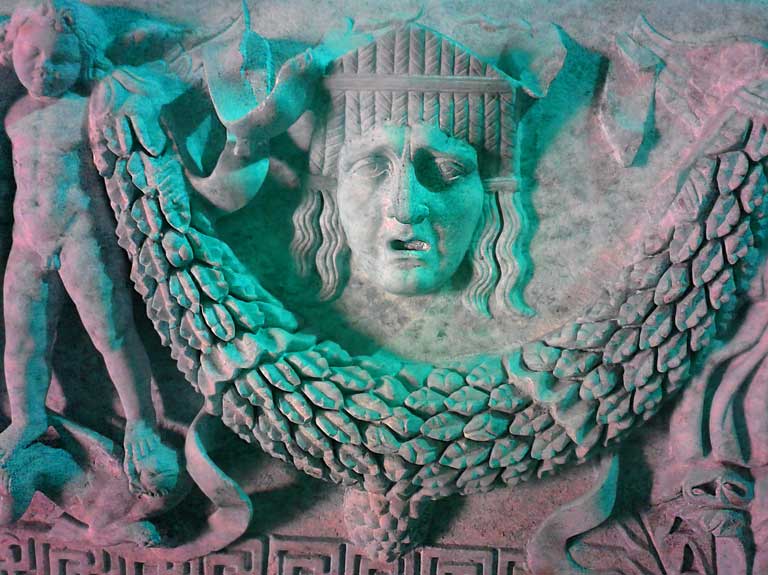
Hierapolis Archaeology Museum used to be a public bathhouse over 2,000 years ago. The museum houses Roman ruins such as authentic Roman Baths, coins, statues, and also sarcophagi. The museum started collecting and displaying ancient artefacts in 1984.
The museum’s displays tell a story about various historical events. When you enter the museum, you will come across a selection of patterned column tops from the agora in Hierapolis. The museum has a room dedicated to the artefacts collected during the excavations at Laodicea and Hierapolis.
4. Hierapolis Theatre
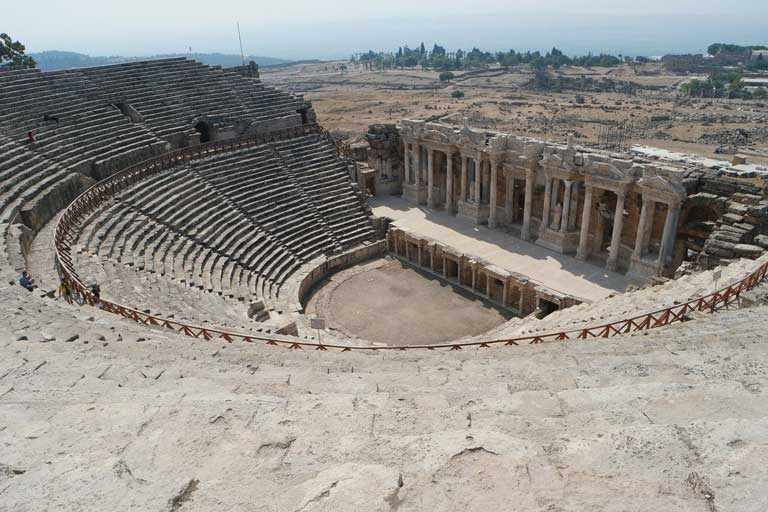
Hierapolis Theatre was built by the Romans over two platforms. When an earthquake destroyed the first theatre, the Romans decided to create a second stage by building it on a hill in the mountain. The theatre could easily accommodate up to 15,000 people. Nine aisles and eight vertical passages divide the theatre. On-going excavations have dug up statues and relics representing mythological beings.
5. Temple of Apollo
You will only find the foundations of the first Apollo Temple because a new Temple was created in the 3rd century. Using a Roman theme, the priests (who looked after the first temple) built another Temple using recycled marble from the original Temple. To visit the Temple of Apollo, see number 8 on the map.
6. Pluto’s Gate
The Ploutonion or Pluto’s Gate is the oldest sanctuary. The structure served as a shrine to Pluto, the God of the Underworld. The small cave had stairs that led to an underground area that experienced continuous geological activity.
Back in the day, the priests believed the mist, which we now know is noxious carbon dioxide, filled the cave because it was a portal to the underworld. Priests used to enter the caves by holding their breath with some not being affected by the toxic gas because the gas mostly accumulated on the ground.
However, they sacrificed animals to honour Pluto by entering the cave with them and coming back unharmed. People perceived this as a miracle, believing that Pluto had given them divine protection and powers. To visit Pluto’s Gate, see number 42 on the map.
7. Martyrium of St. Philip the Apostle
The Martyrium of St. Philip the Apostle was built to honour St. Philip who was one of the twelve Disciples of Christ. People believe that Saint Philip was martyred and buried in the structure. Each arch — there are eight — has chapels decorated with crosses. For the Martyrium of St. Philip the Apostle, see number 12 on the map.
8. Nymphaeum
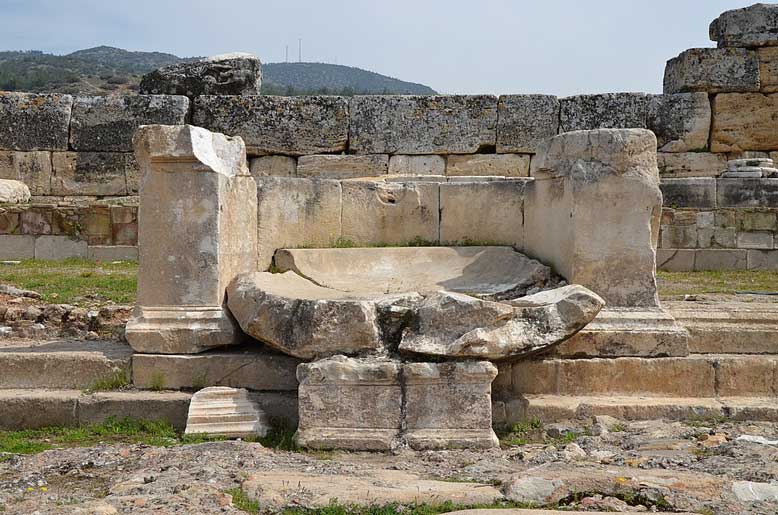
Nymphaeum is a nymph shrine and acts as a fountain for distributing water to homes using a system of pipes. It distributes water to every house in the city. The U-shaped structure has shops and statues situated around it. The structure used to have walls to block Christians from seeing the Pagan Temple.
9. Necropolis at Hierapolis
Necropolis is a gravesite that archaeologists dug up to discover around 1,200 graves made from limestone going back to the Hellenic era. Since people considered the pools in Hierapolis to have curative properties, it’s believed they used to visit it, pass away, and get buried there. To visit the North and East Necropolis, see number 25 and number 27 respectively on the map.
10. Pamukkale Hot Air Balloon

Riding a hot air balloon in Pamukkale, Turkey gives you a glimpse of Cotton Castle from a bird’s eye view. The hot air balloon shows you the entirety of Pamukkale from 1000 metres high in the air.
The amazing cliff, snow-capped mountains, ancient structures, as well as the Cotton Castle will all come into view. Another reason to take a hot air balloon ride is to watch the sunset at Pamukkale, Turkey from high up.
11. Paragliding at Pamukkale

Paragliding gives you access to areas not accessible to tourists. The restricted areas of Cotton Castle will become visible when you glide over them. From the sky, you’ll see the waterfalls, terraced basins, Hierapolis, and Pamukkale.
How to Get to Pamukkale, Turkey?
There are several ways to get to Pamukkale from other major cities in Turkey. You can reach the city by train, bus, car, or take the plane via the airport near Pamukkale, the Denizli-Cardak Airport.
From Pamukkale, the airport is 70 km away. However, there are no direct flights to the city. You will land in the Denizli Province and from there, it’s an hour’s drive. You can take a minibus, shuttle, or taxi to the city.
1. Istanbul to Pamukkale
- Bus is a 10 to 12-hour ride to reach Denizli. From Denizli, take another 20-min bus ride to Pamukkale.
- Sabiha Gokcen Airport to Denizli-Cardak Airport takes 75 min. Take the Pamukkale airport transfer to reach the city.
- Train takes you from Istanbul to Eskisehir. It’s a three-hour ride with a one-night stay in Eskişehir and then an early train leaving for Denizli.
2. Kusadası to Pamukkale
- Buses take you from Kuşadası to Pamukkale. It takes 3 to 4 h to reach Denizli, and then it’s a 16-min ride to Pamukkale.
- Train takes you from Selcuk to Pamukkale. There are no train stations in Kusadası, so you’ll have to take a 13-min bus ride to Selcuk. From there, walk to the train station and in 4 h, you’ll reach Goncali. Take a 12-min taxi ride to Pamukkale.
- Izmir Adnan Menderes Airport has flights that depart for Denizli with a 4-hour journey time. From the province, you can take a bus to Pamukkale.
3. Marmaris to Pamukkale
- Buses can take you to Denizli in 2 to 3 h. From there, take a 16-min taxi ride to Pamukkale.
- Taxis from Marmaris to Pamukkale take 2 to 3 hours.
4. Antalya to Pamukkale
- Buses can take you to Denizli in 2 to 3 h. From there, take a 15-min taxi ride to Pamukkale.
- Antalya Airport offers several nonstop flights from Antalya to Pamukkale. You will reach Denizli in 1 h and 10 min whereas flights with one stop can take 5 h.
Sunset at Pamukkale, Turkey stirs up emotions
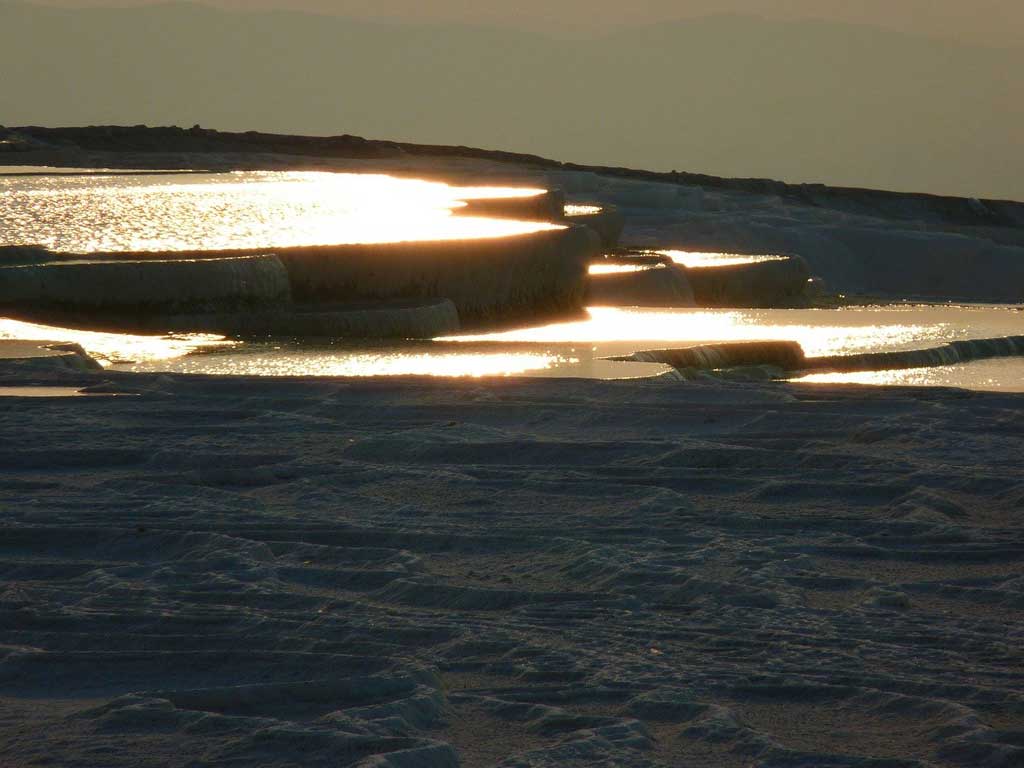
Sunset at Pamukkale, Turkey makes you grateful for the wondrous spectacle before you. Even if you have seen your share of sunsets, those will not compare to the Pamukkale sunset in Turkey. It’s the perfect way to wrap up your trip to the country. Visit Pamukkale for the sunset, the ancient ruins, the pools, and the striking scenery in Turkey.
Pamukkale, Turkey Where the Sun Descends, the Sky Glows, and the Travertine Glistens.

